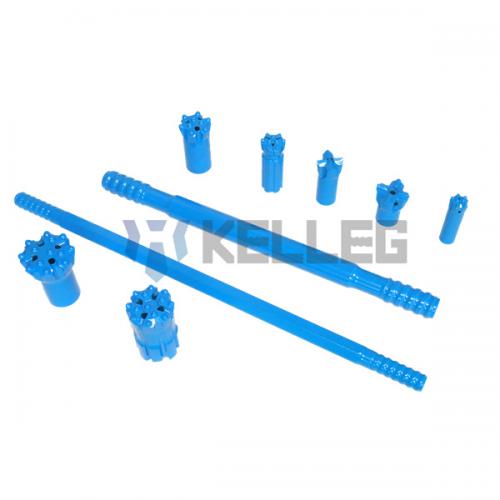Matters needing attention when using cemented carbide for rock drilling tools

Cemented
carbide is an important part of rock drill bits and is known as
"industrial teeth" due to its high hardness, strength, wear
resistance, and corrosion resistance.
Commonly
used cemented carbides include tungsten-cobalt, tungsten-titanium-cobalt, and
tungsten-titanium-tantalum (niobium), each category has a variety of grades.
Due to the ever-changing rocks, the variety of rock drills, and the extremely
harsh working environment, it is impossible to use only one grade of cemented
carbide.
Cemented
carbides suitable for rock drilling must be resistant to damage under impact
load and have high wear resistance. The correct selection of cemented carbide
grades is one of the important factors to ensure the effective use of cemented
carbide rock drilling tools. Therefore, the following points should be paid
attention to when choosing cemented carbide grades:
1.
Physical and mechanical properties of rocks, such as hardness, abrasiveness,
particle size, and characteristics.
2.
Rock drill model.
3.
The method of breaking rocks.
4.
Equipment capacity
In
addition, the inserting, welding, and grinding of cemented carbide for rock
drilling tools is an important process. If mishandled, it is easy to produce an
insert detached from the slot, insert shattered, cracks, debris, and other
defects, so that the service life of cemented carbide tools is reduced.
Matters needing attention when using cemented carbide for
rock drilling tools
1. The inserting methods
used for button alloys are hot inserting, hot pressing, and cold pressing. When
inserting teeth, strictly control the interference and clearance between the
teeth and holes according to the process requirements, finely grind the column
teeth, and eliminate the grinding stress before inserting the teeth.
2. Due to the difference in
thermal conductivity and thermal expansion coefficient between cemented carbide
and shell material, improper handling during welding is prone to cracks. It is
suggested that the welding gap should be controlled between 0.3~0.4 mm, and the
shell should be placed in an incubator for slow cooling after welding.
3. The surface of cemented
carbide should be cleaned before welding and sandblasting and roller grinding
can be used. The grinding process must be carried out under strictly controlled
tumbling process conditions, otherwise, the products with edges and corners are
prone to fall off the edge. It is best to use an organic solvent such as
gasoline or anhydrous ethanol as a cleaning agent to clean the cemented
carbide, and weld immediately after cleaning.
4. When grinding the edge
surface of the shell, a green silicon carbide grinding wheel is used and cooled
with water.
The cemented carbide used
in rock drilling tools should have good toughness. Choosing the cemented
carbide grades reasonably and strictly following the precautions in use can
effectively extend the service life of rock drilling tools.
Comments